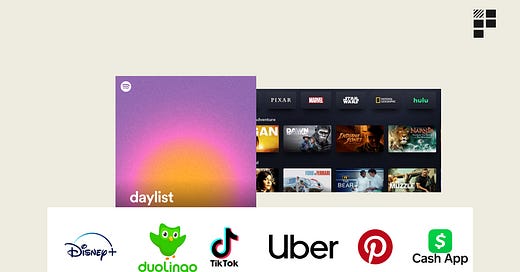Deep: How are companies driving engagement and retention?
New tactics used by top tier companies like Disney, Instacart, Uber and more
🔒DoP Deep goes deeper into the concepts and ideas that are covered in the Weekly Briefing to help you learn lessons from the experiences of top tech companies. If you’d like to upgrade to receive these in-depth pieces of analysis you can do so below. Or you can find out more about what you get as a paid subscriber here.
Hi product people 👋,
In the weekly briefing we recently mentioned that Disney+ was adding a series of new features to boost user retention and engagement. This included things like transactional emails sent to users who start watching a season of a TV show but stop half way through and ML-powered personalised artwork to drive higher converting recommendations.
More recently, a carefully worded notification was found to single-handedly drive a significant percentage of DuoLingo's retention and engagement numbers. And a retention tactic from Spotify even managed to increase engagement for an under-used feature by a massive 20,000%.
With net dollar retention for SaaS products in decline and consumer businesses also facing their own battles with retention, this DoP Deep explores the tactics and features that product teams are currently deploying to boost retention and engagement.
If you’re currently exploring ways to boost your own product’s retention numbers and are looking for some inspiration, this DoP Deep dive should help.
Coming up:
How this deep dive is structured
A deeper look at some of the ways companies like Uber, Pinterest, DuoLingo, Instacart and Disney+ are driving engagement and retention
How Spotify drove engagement of one underused feature by 20,000%
Is the hook model now illegal? The emerging new laws on digital addiction explained
The list of companies featured in full
How this deep dive is structured
To some extent, every feature a product adds is directly or indirectly related to engagement or retention. For the most part, if a feature adds value then it will inevitably drive these up.
But for this deep dive, we’re looking more closely at explicit new features or tactics that have recently been deployed by top tier companies including Uber, Pinterest, Instacart and Disney+ to drive retention and engagement.
The deep dive is structured to include:
Company / product - the company featured
Category - the product category for the company featured. This deep dive includes a variety of different categories including transportation, media and entertainment, social, SaaS and more
Retention or engagement tactics - the retention and engagement tactics used by each company. This includes machine learning, gamification, UX improvements and other tactics.
Examples - a detailed summary of some examples of how these retention tactics are used by each company.
Links to more information - links to find out more about the examples cited.
Retention and engagement tactics explained
This isn’t an exhaustive list of all features and tactics used by each of the companies in the deep dive, but rather it’s a selection of some of the most recently deployed examples of retention and engagement drivers.
You can see a snapshot of the companies featured along with their engagement tactics here. The full list is available for paid subscribers at the end of the post.
To help structure the analysis, the retention and engagement tactics are categorised into the following:
ML models - personalization through machine learning models whic help recommend relevant content, products, or services, and increase user engagement. This can also include predictive analytics that allow for anticipating user behavior which can pre-empt things like churn.
Marketing campaigns - targeted marketing campaigns keep users informed about new features, offers, and updates, encouraging ongoing interaction and increasing retention.
Gamification - incorporating game-like elements, such as rewards and challenges, motivates users to engage more frequently and for longer periods, improving retention. Companies like Peloton, Spotify as well as DuoLingo do this.
Transactional emails - provide important updates related to user actions to keep users informed and engaged.
Customer service - excellent customer service ensures that user issues are resolved promptly, leading to higher satisfaction and encouraging continued use of the service. CashApp CEO Jack Dorsey recently announced that the company would be doubling down on this as a differentiator to drive retention, for example.
Push notifications - push notifications can re-engage users by reminding them of unfinished tasks, new content, or personalized offers, boosting both engagement and retention. We’ll look at some examples of how top tier companies are using this in creative ways.
Native currencies - not something you might traditionally associate with retention and engagement, but a native currency system can encourage engagement by providing incentives, such as discounts or rewards, for regular engagement with the platform. Companies like Telegram and DuoLingo have native currencies and use these to drive engagement.
UX improvements - UX improvements can make the product more intuitive and enjoyable to use, reducing frustration and encouraging users to stay engaged. We’ll share some examples of how companies like Coinbase are doing this.
A deeper look at some of the ways companies like Disney+, Uber, DuoLingo and Pinterest are driving engagement and retention
Let’s take a deeper look at some of the examples featured.
DuoLingo
Retention tactic example: emotionally-driven push notifications
A product exec at DuoLingo recently revealed that a single, carefully crafted notification significantly drove up retention and engagement figures. And the reason it was so successful is because it made users actually feel something thanks to its emotive language.
Here’s the notification DuoLingo used:




